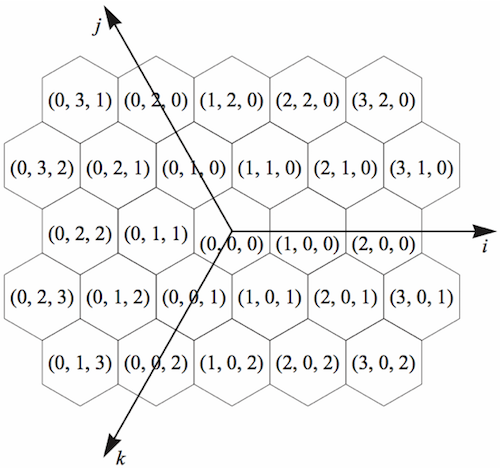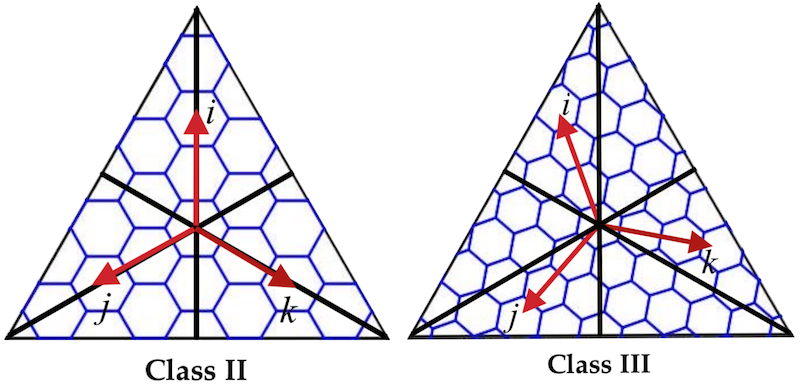Coordinate systems
The H3 Core Library uses the following coordinate systems internally.
IJK Coordinates
Discrete hexagon planar grid systems naturally have 3 coordinate axes spaced 120° apart. We refer to such a system as an ijk coordinate system, for the three coordinate axes i, j, and k. A single ijk coordinate triplet is represented in the H3 Core Library using the structure type CoordIJK.
Using an ijk coordinate system to address hexagon grid cells provides multiple valid addresses for each cell. Normalizing an ijk address (function _ijkNormalize) creates a unique address consisting of the minimal positive ijk components; this always results in at most two non-zero components.

FaceIJK Coordinates
The H3 Core Library centers an ijk coordinate system on each face of the icosahedron; the combination of a face number and ijk coordinates on that face's coordinate system is represented using the structure type FaceIJK.
Each grid resolution is rotated ~19.1° relative to the next coarser resolution. The rotation alternates between counterclockwise and clockwise at each successive resolution, so that each resolution will have one of two possible orientations: Class II or Class III (using a terminology coined by R. Buckminster Fuller). The base cells, which make up resolution 0, are Class II.

Hex2d Coordinates
A Hex2d coordinate system is a cartesian coordinate system associated with a specific ijk coordinate system, where:
- the origin of the Hex2d system is centered on the origin cell of the ijk system,
- the positive x-axis of the Hex2d system is aligned with the i-axis of the ijk system, and
- 1.0 unit distance in the Hex2d system is the distance between adjacent cell centers in the ijk coordinate system.
Hex2d coordinates are represented using the structure type Vec2d.
Local IJ Coordinates
Algorithms working with hexagons may want to refer to grid coordinates that are not interrupted by base cells or faces. These coordinates have 2 coordinate axes spaced 120° apart, with the coordinates anchored by an origin H3 index.
- local coordinates are only comparable when they have the same origin index.
- local coordinates are only valid near the origin. Pratically, this is within the same base cell or a neighboring base cell, except for pentagons.
- the coordinate space may have deleted or warped regions due to pentagon distortion.
- there may be multiple coordinates for the same index, with the same origin.
- the origin may not be at
(0, 0)in the local coordinate space.
Local IJ coordinates are represented using the structure type CoordIJ and an associated origin H3Index.